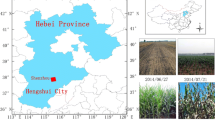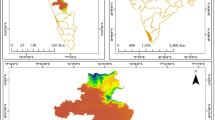Abstract
In this paper, a new method for canopy water content (FMC) estimation for highly vegetated surfaces-shortwave infrared perpendicular water stress index (SPSI) is developed using NIR, SWIR wavelengths of Enhanced Thematic Mapper Plus (ETM+) on the basis of spectral features and distribution of surface targets with different water conditions in NIR-SWIR spectral space. The developed method is further explored with radiative transfer simulations using PROSPECT, Lillesaeter, SailH and 6S. It is evident from the results of validation derived from satellite synchronous field measurements that SPSI is highly correlated with FMC, coefficient of determination (R squared) and root mean square error are 0.79 and 26.41%. The paper concludes that SPSI has a potential in vegetation water content estimation in terms of FMC.
Similar content being viewed by others
References
Riãno D, Vaughan P, Chuvieco E, et al. Estimation of fuel moisture content by inversion of radiative transfer models to simulate equivalent water thickness and dry matter content: analysis at leaf and canopy level. IEEE Trans Geosci Remote Sensing 2005, 43(4): 819–826
Eidenshink J C, Burgan R E, Haas R H. Monitoring fire fuels condition by using time series composites of Advanced Very High Resolution Radiometer (AVHRR) Data. In: Proceedings of Resource Technology. Washington, DC: ASPRS, 1990. 68–82
Alonso M, Camarasa A, Chuvieco E, et al. Estimating temporal dynamics of fuel moisture content of Mediterranean species from NOAA-AVHRR data. EARSeL Adv Remote Sens, 1996, 4(4): 9–24
Burgan R E. Use of remotely sensed data for fire danger estimation. EARSeL Adv Remote Sens, 1996, 4(4): 1–8
Paltridge G W, Barber J. Monitoring grassland dryness and fire potential in Australia with NOAA/AVHRR data. Remote Sens Environ, 1998, 25: 381–394
Illera P, Fernandez A, Delgado J A. Temporal evolution of the NDVI as an indicator of forest fire danger. Int J Remote Sens, 1996, 17(6): 1093–1105
Tucker C J. Remote sensing of leaf water content in the near-infrared. Remote Sens Environ, 1980, 10: 23–32
Jackson R D, Slater P N, Pinter P J Jr. Discrimination of growth and water stress in wheat by various vegetation indices through clear and turbid atmospheres. Remote Sens Environ, 1983, 13: 187–208
Gao B. NDWI-a normalized difference water index for remote sensing of vegetation liquid water from space. Remote Sens Environ, 1996, 58: 257–266
Ceccato P, Flasse S, Tarantola S, et al. Detecting vegetation leaf water content using reflectance in the optical domain. Remote Sens Environ, 2001, 77: 22–33
Fourty T, Baret F. Vegetation water and dry matter contents estimation from top-of the atmosphere reflectance data: a simulation study. Remote Sens Environ, 1997, 61: 34–45
Ustin S L, Roberts D A, Pinzon J, et al. Estimating canopy water content of chaparral shrubs using optical methods. Remote Sens Environ, 1997, 65: 280–291
Zarco-Tejada P J, Rueda C A, Ustin S L. Water content estimation in vegetation with MODIS reflectance data and model inversion methods. Remote Sens Environ, 2003, 85: 109–124
Ceccato P, Gobron N, Flasse S, et al. Designing a spectral index to estimate vegetation water content from remote sensing data: Part 1. Theoretical approach. Remote Sens Environ, 2002, 82: 188–197
Ceccato P, Flasse S, Gregoire J M. Designing a spectral index to estimate vegetation water content from remote sensing data: Part 2. Validation and applications. Remote Sens Environ, 2002, 82: 198–207
Bowyer P, Danson F M. Sensitivity of spectral reflectance to variation in live fuel moisture content at leaf and canopy level. Remote Sens Environ, 2004, 92(3): 297–308
Danson F M, Bowyer P. Estimating live fuel moisture content from remotely sensed reflectance. Remote Sens Environ, 2004, 92: 309–321
Sims D A, Gamon J A. Estimation of vegetation water content and photosynthetic tissue area from spectral reflectance: A comparison of indices based on liquid water and chlorophyll absorption features. Remote Sens Environ, 2002, 84: 526–537
Roberts D A, Green R O, Adams J B. Temporal and spatial patterns in vegetation and atmospheric properties from AVIRIS. Remote Sens Environ, 1997, 62: 223–240
Hardisky M A, Klemas V, Smart R M. The influence of soft salinity, growth form, and leaf moisture on the spectral radiance of Spartina alterniflora canopies. Photogr Eng Remote Sens, 1983, 49: 77–83
Hunt Jr E R, Rock B N, Nobel P S. Measurement of leaf relative water content by infrared reflectance. Remote Sens Environ, 1987, 22: 429–435
Penuelas J, Filella I, Biel C, et al. The reflectance at the 950–970 nm region as an indicator of plant water status. Int J Remote Sens, 1993, 14: 1887–1905
Maki M, Ishiahra M, Tamura M. Estimation of leaf water status to monitor the risk of forest fires by using remotely sensed data. Remote Sens Environ, 2004, 90: 441–450
Jacquemoud S, Baret F. PROSPECT: a model of leaf optical properties spectra. Remote Sens Environ, 1990, 34: 75–91
Elvidge C D, Lyon R J P. Estimation of the vegetation contribution to the 1.65/2.22μm ratio in airborne thematic-mapper imagery of the Virginia Range, Nevada. Int J Remote Sens, 1985, 6: 75–88
Chuvieco E, Riãno D, Aguado I, et al. Estimation of fuel moisture content from multitemporal analysis of Landsat Thematic Mapper reflectance data: applications in fire danger assessment. Int J Remote Sens, 2002, 23(11): 2145–2162
Shipley B, Vu T T. Dry matter content as a measure of dry matter content concentration in plants and their parts. New Phytologist, 2002, 153: 359–364
Lillesaeter O. Spectral reflectance of partly transmitting leaves-Laboratory measurements and mathematical modeling. Remote Sens Environ, 1982, 12: 247–254
Nilson T, Kuusk A. Simulation of reflectances spectra in boreal coniferous forest. In: Sobrino J A ed. Proceedings of the First International Symposium on Recent Advances in Quantitative Remote Sensing. Torrenta (Valencia). Spain: Universitat de València, 2002. 31–38
Author information
Authors and Affiliations
Corresponding author
Additional information
Supported by the Special Funds for the Major State Basic Research Project (973) (Grant No. G2000077900), the High-Tech Research and Development Program of China (Grant No. 2001AA135110) and EAGLE (Exploitation of AnGular Effects in Land Surface Observation From Satellites in the Sixth Framework Program (FP6) of EU) (Grant No. SST3CT2003502057)
Rights and permissions
About this article
Cite this article
Ghulam, A., Li, ZL., Qin, Q. et al. A method for canopy water content estimation for highly vegetated surfaces-shortwave infrared perpendicular water stress index. SCI CHINA SER D 50, 1359–1368 (2007). https://doi.org/10.1007/s11430-007-0086-9
Received:
Accepted:
Issue Date:
DOI: https://doi.org/10.1007/s11430-007-0086-9




